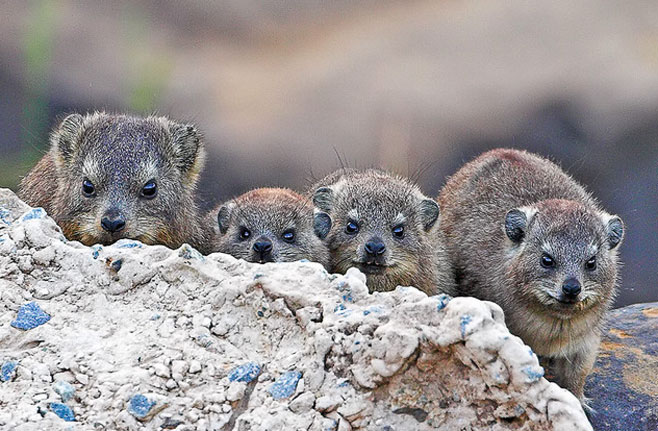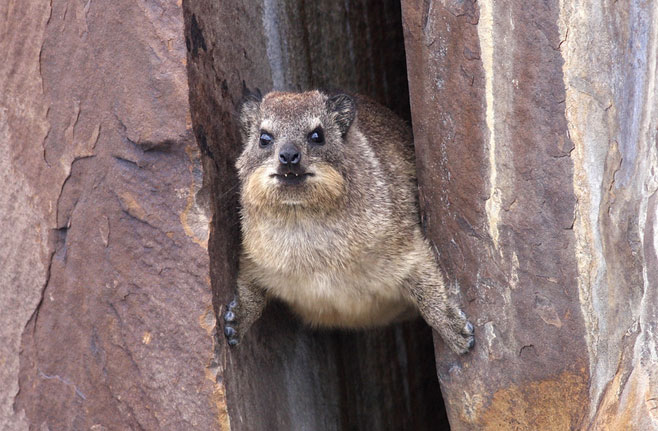|
Procavia capensis
(Rock hyrax, Dassie)
rock dassie, rock rabbit [English];
klipdas, klipdassie [Afrikaans];
Klippschliefer [German];
daman de rocher [French];
pimbe [Swahili];
imbila [isiNdebele] [isiXhosa] [isiZulu] [siSwati];
pela, thobela, thewbela [Sepedi];
pela [Sesotho] [Setswana];
mbila [Shona] [Xitsonga] [Tshivenda];
!Aus [Nama] [Damara]
Life
>
Eukaryotes >
Opisthokonta >
Metazoa (animals) > Bilateria > Deuterostomia >
Chordata > Craniata > Vertebrata (vertebrates) >
Gnathostomata (jawed vertebrates) > Teleostomi (teleost
fish) > Osteichthyes (bony fish) > Class:
Sarcopterygii (lobe-finned fish) > Stegocephalia
(terrestrial vertebrates) > Reptiliomorpha > Amniota >
Synapsida (mammal-like reptiles) > Therapsida > Theriodontia
> Cynodontia > Mammalia (mammals)
> Placentalia (placental mammals) >
Afrotheria > Paenungulata > Hyracoidea (hyraxes)
 |
|
A group of Dassies at Ventersburg, Free State,
South Africa. [photo Gerhard Theron
©] |
 |
|
Rock hyrax, Tanqua Karoo National Park, Western
Cape, South Africa. [photo
Johan van
Rensburg ©] |
Identification
The Dassie is small and stoutly built with
short legs and a short rudimentary stump for a tail. In spite of its
small rounded ears it has the appearance of a rabbit. A patch of
black hair overlies a glandular area in the middle of the back. The
feet are short and have rubbery pads with many sweat glands
underneath. The sweat glands are important both for heat loss and
provide the soles of the feet with remarkable traction on the rock
surfaces.
Although dassies look like rodents their
evolutionary relationships are closest to the elephant and the
dugong.
Size
Body Length 45 - 60 cm; weight range 2.5 - 4.6 kg
Dentition
Dassies crop vegetation with the sides of their
mouths, using their molars instead of the incisors as most mammals
do. Their dentition is unusual. The 2 upper incisors resemble a
short tusk-like canine. The shape of this canine in cross-section is
sexually dimorphic, males have a triangular cross-section and
females are more rounded in shape. There are 4 lower incisors.
Dental Formula:
I C C
 P P M M =
32 =
32
Distribution and habitat
Widely distributed in South Africa, preferring
rocky areas in mountain ranges and isolated
outcrops.
General behaviour
Dassies have a poor ability to regulate their body
temperature and a low metabolic rate. They become active after
sunrise and usually bask in the sun for some time before moving off
to feed. During cooler periods and at night groups are seen to
huddle together to keep each other warm. Rock hyraxes spend a lot of
time crouching motionless on rocks and seemingly staring directly
into the sun. This important for survival as birds of prey often
attack directly out of the sun. The dassie has a special membrane
(umbraculum) that shades the pupil of the eye.
Dassies have minimal water requirements and
can get their water from the vegetation in their diet or from pools
in the rocks. In addition, they can concentrate urea and
electrolytes and excrete large amounts of undissolved calcium
carbonate. Dassies have latrines, where they deposit their droppings
and urine at a fixed site. The crystallized calcium carbonate forms
white deposits on the rock surfaces. These crystals, known as
“dassie piss” were believed to have medicinal properties and were
used by indigenous tribes and Europeans.
Food
They eat a wide range of plants and are both
grazers and browsers.
Reproduction
-
After a gestation period of 210 to 240
days, lengthy for a small mammal,
the young are born fully haired with their eyes open and look like
perfect miniatures of the adult. Although like all mammals they do
suckle milk from their mothers they are able to move about and eat
vegetation soon after birth.
Life span
10-12 years
Conservation
While not currently listed as threatened
dassies are threatened by habitat loss and disturbance from
agriculture and urban encroachment. They are hunted by a variety of
predators, including leopard, caracal, black eagles and others.
Dassie skins are extremely tough and are sought after by hunters,
who use them to make long – lasting rugs (kaross).
Publications
-
Deschodt, C., Kryger, U., Scholtz, C.H.
2007. New taxa of relictual Canthonini dung beetles (Scarabaeidae:
Scarabaeinae) utilizing rock hyrax middens as refuges in
south-western Africa. Insect Systematics and Evolution.
38:361-376.
|
